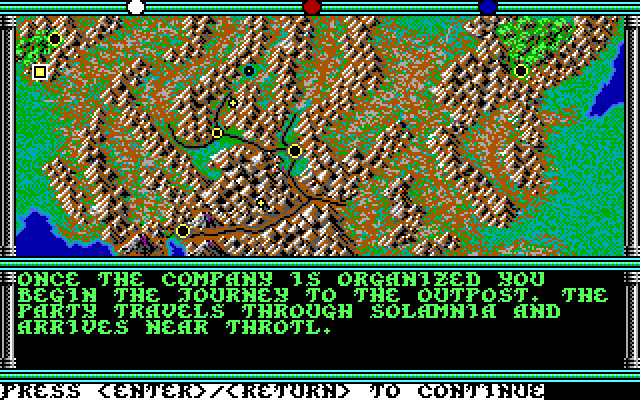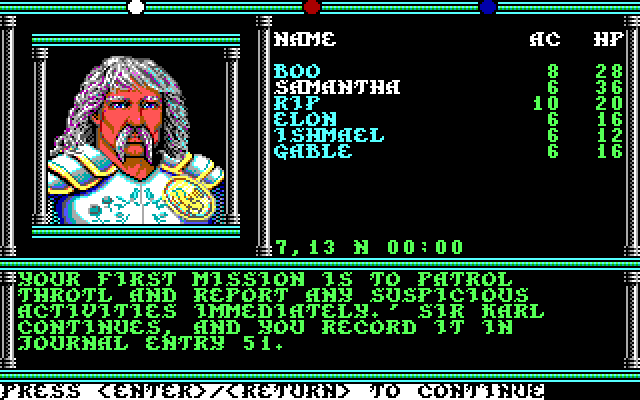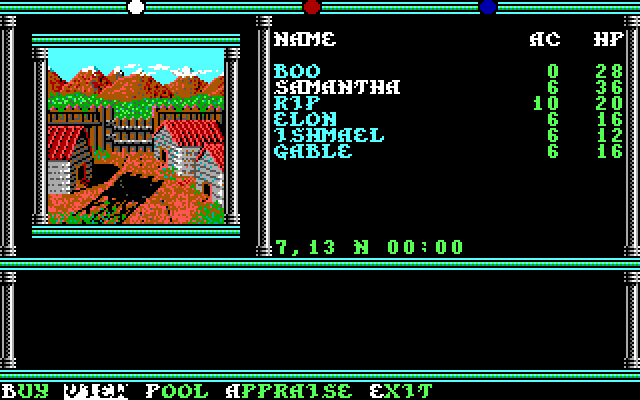Sometimes a new solution is just an old idea in a new package.
Last time, I covered how re-reading the Dragonlance novels got me thinking about a new kind of RPG. One that is a realistic open world, procedurally-generated, and full of meaningful choices. The question is: How can I build it? Is it even possible?
Shark Tank is a TV show where prospective entrepreneurs (fish) pitch their business ideas to industry titans (sharks). After one of these pitches, Kevin (the grumpy Simon type billionaire on the show) asked, “Which is more important: The idea or the execution?”
Thinking for a minute, the entrepreneur nervously answered “Execution.”
“Right answer,” said Kevin. And he proceeded to invest in the idea.
I had a solid idea, but I wasn’t so sure about how to execute it. If I want to allow the player true choice, I have to address the cost of choice head on. I found the answer in two places: another TV show . . . and the early ‘90s.
Cost of Player Choice
There is one reason why the same characters die at the same time both in my playthrough and yourplaythrough of Watch Dogs: cost. Video game budgets now eclipse movies by a considerable margin—leading to less relevant choices.

Two aspects of cost affect choice:
1) The industry has painted itself into a corner; everything must be a 3D model and fill a 1080p (and soon 4K) framebuffer. For your character to have a dragon mount, someone has to model, rig, and animate it. If your character speaks to you, someone has to record a voice actor acting the lines. What if the designer wanted to add a Pegasus? A griffon? A wyvern? Four mount choices is four times the cost. So the narrower the player’s choices, the lower the cost.
2) Branching paths lead to unplayed segments of the game. Let’s say it costs $1 million to create one hour of game content. Let’s also say we want to offer the player a 10-hour experience. Imagine that our inspired game designer wants to have three totally different branches of the game based solely on player choice. This means $30 million in cost, but the player only sees $10 million of it. From a player’s perspective, the other $20 million might as well not be there. That hurts when you’re footing the bill and don’t even know how many units you will be able to sell. Contrast this with a movie: Every dollar spent is experienced by the audience—a 1:1 ratio. This isn’t so with games: The higher the ratio of “experience vs spend,” the better the producer feels about the whole thing.
So the only way I see to offer players real choice is to greatly reduce the cost of choice in the first place. Reduce it down so low that (from a cost perspective) it doesn’t really matter what they choose.
But would reducing this cost somehow lose the magic found in role-playing? Fortunately, watching TV gave me the answer.
Community
If you don’t know Abed, you should.
Community is a comedy TV show about community college. Outcasts decide to form a study group, and hilarity ensues. In one of the later episodes Abed (a super geek) runs a D&D game for the group to cheer up a fellow student. Whether you have played D&D or not, the episode is ridiculously funny. They managed to write something both my wife and I enjoyed, yet for entirely different reasons. Beyond this, it is also a brilliant showcase of role-playing at its finest.
Abed is the Dungeon Master (or GM). He simply tells the context of what is happening, and asks the characters what they want to do. There are a few dice rolls, but it is mostly just the characters making simple choices from the options Abed gives them. Sid Meier said it so clearly: “Games are a series of interesting choices.” It is so simple . . . yet incredibly easy to forget. Something inside us seeks a morecomplicated solution.
Much of what I see in role-playing tabletop (be it the miniatures with grid map or rule books galore) and role-playing computer games (simply moving from A to B, FedEx quests, forever rearranging my inventory) is minutia, which gets in the way of the really interesting choices. But what if a game is solelyfocused on interesting choices?
Community helped me see role-playing in its simplest, purest form. I had to be reminded of what role-playing once was back in the late ‘80s and early ‘90s—when developers weren’t tempted to throw in the proverbial kitchen sink.
SSI Goldbox (1988-1993)
In four-ish years, SSI released a total of 14 AAA (for the time) role-playing games. Many people fell in love with Pools of Radiance (the first game)—but for me, it began with the Dragonlance themedChampions of Krynn trilogy. It doesn’t matter. They play similarly due to sharing almost identical game design and engine.

The SSI games had to do a lot with little computing power and even less memory. Some of them ran on the Commodore 64—which for reference, only had 64 kilobytes of memory. An impressive feat when you consider that there are dozens of types of enemies, equipment, treasure, settings, weapons, and spells. Character creation alone has 9 races and 7 class types—63 possible combinations before you even get into multi-classing.
How could they pull this off? Short answer: Text and imagination.
They used basic graphics to set the mood, then used text to feed the player’s imagination. Did it work? You bet! I and many others have extremely fond memories from that era.
Here are three examples of how these games played:

This is the overworld map in Champions of Krynn. You are the square. The circles are locations you know of. You can get from your starting location to a quest location using the cursor keys in about 12 seconds. Contrast this with all the running around in Final Fantasy or Skyrim. Once you know where you want to go, decide to go, it takes tons of time to get there. I believe deciding where to go next is an interesting decision. Actually travelling there is not.

This is an interaction with an NPC. There is an image of the character you’re talking with (for context), and then text describing what they say or what is happening. As an aside, I like how they made it even more minimalist by telling you to go to the included physical game journal to read the rest of the text.

And finally, here is navigating a town. You decide the stores/locations you wish to visit by selecting the name below, and bam!—you are there and can start buying/selling. Now contrast this with Skyrim’sWhiterun where I have to run from my house to the general store, to the castle wizard, back again to the center of town for the other vendors. It’s just so much running around to execute a decision I already made minutes ago! Ironically, Skyrim’s creators recognized this and put in a fast travel system. Well, what I’m talking about is an RPG that only has fast travel with zero wild goose chases and absolutely no running around.
Pictures suppress imagination
When we start life, we cannot read. So what do our children’s storybooks have? Big pictures and little-to-no text. Later in life, we can read The Lord of the Rings (which is all text and a few maps)–but as our comprehension and imagination mature, books decrease what is shown and increase what you shouldimagine. Yet AAA games have gone the other way; they spend millions to try to replace imagination.
Chris Crawford makes this point in his 2003 book, Chris Crawford on Game Design. He states that chasing reality with graphics is a fool’s errand. If the game world is super-realistic, the character models will break the suspension of disbelief. If the character models are super-realistic, then the animation will break it. If the animation is super-realistic, then the player choices will break it. We will never replicate reality in a video game, so why are we trying so hard to get to a destination that’s impossible to reach?
“Good artists copy, but great artists steal.” – Picasso
If you thought I was only stealing from the ‘90s, you would be wrong. Having acquired a taste for creative theft, I am plundering the following modern era games as well:
Wolf Among Us / Walking Dead – Branching storylines based on character choice. Telltale’s games are well-made and have significant cost to their choices. Therefore, there are limited actual branches. I will be offering more choice than their current titles.
Mass Effect 1 / Dragon Age Origins – I found the ability to choose your allies and befriend certain NPCs compelling. There is also some story branching. I plan to take this further.
Skyrim – The most open world AAA game I have played. I like that the player can decide to simply kill a random NPC—and the guards react. And even if you get away, people still remember what you did. I am stealing this core concept of openness with consequences and taking it further.
Dwarf Fortress – A hardcore indie game where you try to found a dwarven settlement in a procedurally-generated world. Extremely challenging to figure out how to play, but worth it. I have spent the last few months developing my own procedural world generation with Dwarf Fortress as a conceptual guide.
Red Shirts – An indie game about relationship management. It’s billed as “facebooking in space.” This game showed me how complex NPC interactions can be achieved in a simple and fun manner. Also as an aside, this is a great example of what a female game designer can bring to the table: totally new ideas where we all benefit. I cannot imagine a man designing this type of game.
The way forward
I am taking the elements I think are worthwhile (the gold) from ‘90s era RPGs and bringing it to a modern context. By making the game in 2D—aided by the strategic sprinkling of amazing art, betting on a well-written script, and engaging the player’s imagination at all times—I believe I have effectively reduced the cost of choice. Therefore, I can greatly increase player choice and the world’s reaction to it.
Not only this, the game plays faster. A boon to those of us with only a few hours a week to game because of other responsibilities – like kids 🙂
I get that requiring players to read and utilize their imaginations will limit the size of the game’s total player base. I’m OK with this. I toughed it out and figured out how to play Dwarf Fortress. I left that game with some great memories. Last year’s big budget SimCity did not reach the same heights—to put it mildly.
You may be wondering: If these ideas are so good, has anyone done something like this before? And if so, were they successful?
Well I’m happy to say that I’m not the first or only person thinking this way. There is another indie game that implemented many of these concepts in 2012. Maybe you heard of it. It’s FTL.
FTL is a sci-fi game where you guide your ship and crew from one edge of the galaxy to another in a certain time period. At each jump along the way, the game presents you with choices. It implements many of the ideas I’m talking about here for Archmage Rises:
- simple 2D context graphics
- text describing the details of what is going on
- text for the choices the player makes
- no flying around; just “jump, make a decision,” “jump, make a decision”
- procedurally-generated universe so that it’s different every time you play
- permadeath (you only have one ship and one crew; let’s see how far you can go!)
Conceptually, I suppose you can say that Archmage Rises is FTL with mages in a fantasy world. This probably gives you the best idea of what Archmage Rises plays like.
If you haven’t already done so, let me encourage you to sign up for the Archmage Rises newsletter. I am making a video tour of the current build; newsletter subscribers will be the first to see it!
Thanks for the emails, tweets, and posts. Your enthusiasm for Archmage Rises will get this game made. Stay tuned.
SGD
Links:
Any questions on the game can be posted on the Facebook page. I answer questions almost every day.
Archmage Rises Website: archmagerises.com
Twitter: @LordYabo


